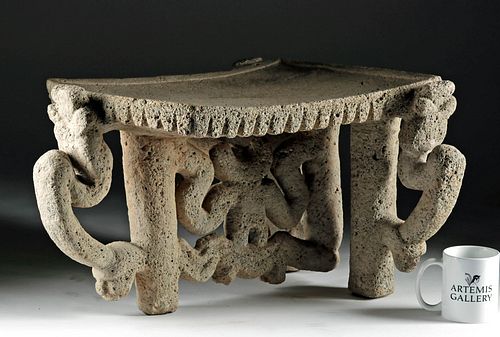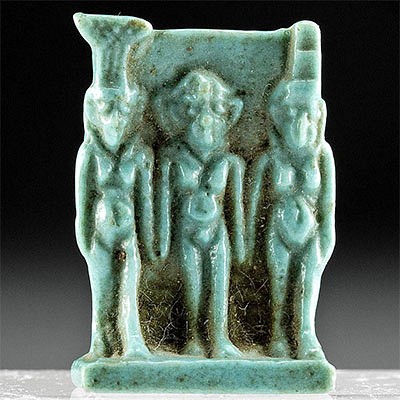Costa Rican Stone Flying Panel Metate - Zoomorphs
Lot 182
About Seller
Artemis Fine Arts
686 S Taylor Ave, Ste 106
Louisville, CO 80027
United States
Selling antiquities, ancient and ethnographic art online since 1993, Artemis Gallery specializes in Classical Antiquities (Egyptian, Greek, Roman, Near Eastern), Asian, Pre-Columbian, African / Tribal / Oceanographic art. Our extensive inventory includes pottery, stone, metal, wood, glass and textil...Read more
Estimate:
$9,500 - $14,250
Absentee vs Live bid
Two ways to bid:
- Leave a max absentee bid and the platform will bid on your behalf up to your maximum bid during the live auction.
- Bid live during the auction and your bids will be submitted real-time to the auctioneer.
Bid Increments
| Price | Bid Increment |
|---|---|
| $0 | $25 |
| $300 | $50 |
| $1,000 | $100 |
| $2,000 | $250 |
| $5,000 | $500 |
| $10,000 | $1,000 |
| $20,000 | $2,500 |
| $50,000 | $5,000 |
| $100,000 | $10,000 |
| $200,000 | $20,000 |
About Auction
By Artemis Fine Arts
Aug 5, 2021
Set Reminder
2021-08-05 10:00:00
2021-08-05 10:00:00
America/New_York
Bidsquare
Bidsquare : VARIETY SALE | Antiquities & Ethnographic Art
https://www.bidsquare.com/auctions/artemis-gallery/variety-sale-antiquities-ethnographic-art-7292
Featuring classical antiquities, ancient and ethnographic art from cultures encompassing the globe. Egyptian, Greek, Roman, Etruscan, Near Eastern, Asian, Pre-Columbian, Native American, African / Tribal, Oceanic, Spanish Colonial, Russian, Fossils, Fine Art, more! Artemis Fine Arts info@artemisfinearts.com
Featuring classical antiquities, ancient and ethnographic art from cultures encompassing the globe. Egyptian, Greek, Roman, Etruscan, Near Eastern, Asian, Pre-Columbian, Native American, African / Tribal, Oceanic, Spanish Colonial, Russian, Fossils, Fine Art, more! Artemis Fine Arts info@artemisfinearts.com
- Lot Description
Pre-Columbian, Central America, Costa Rica, Atlantic Watershed region, ca. 1st to 5th century CE. An enormous flying panel ceremonial metate, expertly carved from a single piece of volcanic stone with refined dimensions and intricately shaped zoomorphic embellishments. The flat metate face is slightly recessed and surrounded by a thick border decorated with incised frets, and the metate itself is supported by three thick conical legs. An abstract bat figure is shown centered on the underside with sinuous wings and a massive nose and stands atop the back of an abstract mammal, perhaps a jaguar. The curved handles projecting from each leg represent snakes with their heads collared near the bases by the down-facing beaks of stylized toucans perched atop the serpentine bodies. A wonderful and elegant example of early Costa Rican artistry! Size: 23.25" L x 20.25" W x 13.25" H (59.1 cm x 51.4 cm x 33.7 cm).
This ceremonial metate carved from volcanic stone represents one of the most unusual traditions of the ancient Americas. While some metates were used as grinding slabs, others showing more intricate designs like this example were intended for ritualistic ceremonies and as burial offerings. It has also been suggested that some metates were actually used as thrones for rulers to sit on. The iconographic/decorative program of this metate suggests a ceremonial function. The ornament may be related to the owner the piece or the ritual in which the metate was used.
According to several scholars, in the Pre-Columbian world, the graceful soaring flight of birds inspired the ancients to see them as metaphors for the sun. Furthermore, given their ability to fly to impressive heights and make dramatic dives, these birds also were believed to communicate with the celestial gods. Jaguar imagery also symbolized power and might throughout the Pre-Columbian world; hence, warriors, rulers, hunters, and shamans alike associated themselves with this king of beasts, the largest and most powerful feline in the New World. Given this symbolism, the iconography on this ceremonial metate would have been particularly fitting for an elite leader of ancient Costa Rica. Such powers and abilities were not only adopted by shamans, but also appropriated by the elite ruling class.
For a stylistically-similar example featuring primarily jaguars, please see The Metropolitan Museum of Art, accession number 1986.200: https://www.metmuseum.org/art/collection/search/314952
A stylistically-similar example of a somewhat larger size hammered for $30,000 at Sotheby's, New York "African, Oceanic and Pre-Columbian Art" auction (May 7, 2016, lot 106): http://www.sothebys.com/en/auctions/ecatalogue/2016/african-oceanic-pre-columbian-art-n09502/lot.106.html
Provenance: private Hawaii, USA collection; exhibited at the Everson Art Museum, Syracuse, New York, USA
All items legal to buy/sell under U.S. Statute covering cultural patrimony Code 2600, CHAPTER 14, and are guaranteed to be as described or your money back.
A Certificate of Authenticity will accompany all winning bids.
Replace: PLEASE NOTE: Due to recent increases of shipments being seized by Australian & German customs (even for items with pre-UNESCO provenance), we will no longer ship Replace: most antiquities and ancient Chinese art to Australia & Germany. For categories of items that are acceptable to ship to Australia or Germany, please contact us directly or work with your local customs brokerage Replace: firm.
Display stands not described as included/custom in the item description are for photography purposes only and will not be included with the item upon shipping.
#132063Repaired from multiple large pieces with resurfacing and adhesive residue along break lines. Minor abrasions to top, legs, and carved animals, with softening to some finer details, and light encrustations within some recessed areas. Light earthen deposits throughout.Condition
- Shipping Info
-
All shipping is handled in-house for your convenience. Your invoice from Artemis Gallery will include shipping calculation instructions. If in doubt, please inquire BEFORE bidding for estimated shipping costs for individual items.
-
- Buyer's Premium



 EUR
EUR CAD
CAD AUD
AUD GBP
GBP MXN
MXN HKD
HKD CNY
CNY MYR
MYR SEK
SEK SGD
SGD CHF
CHF THB
THB











